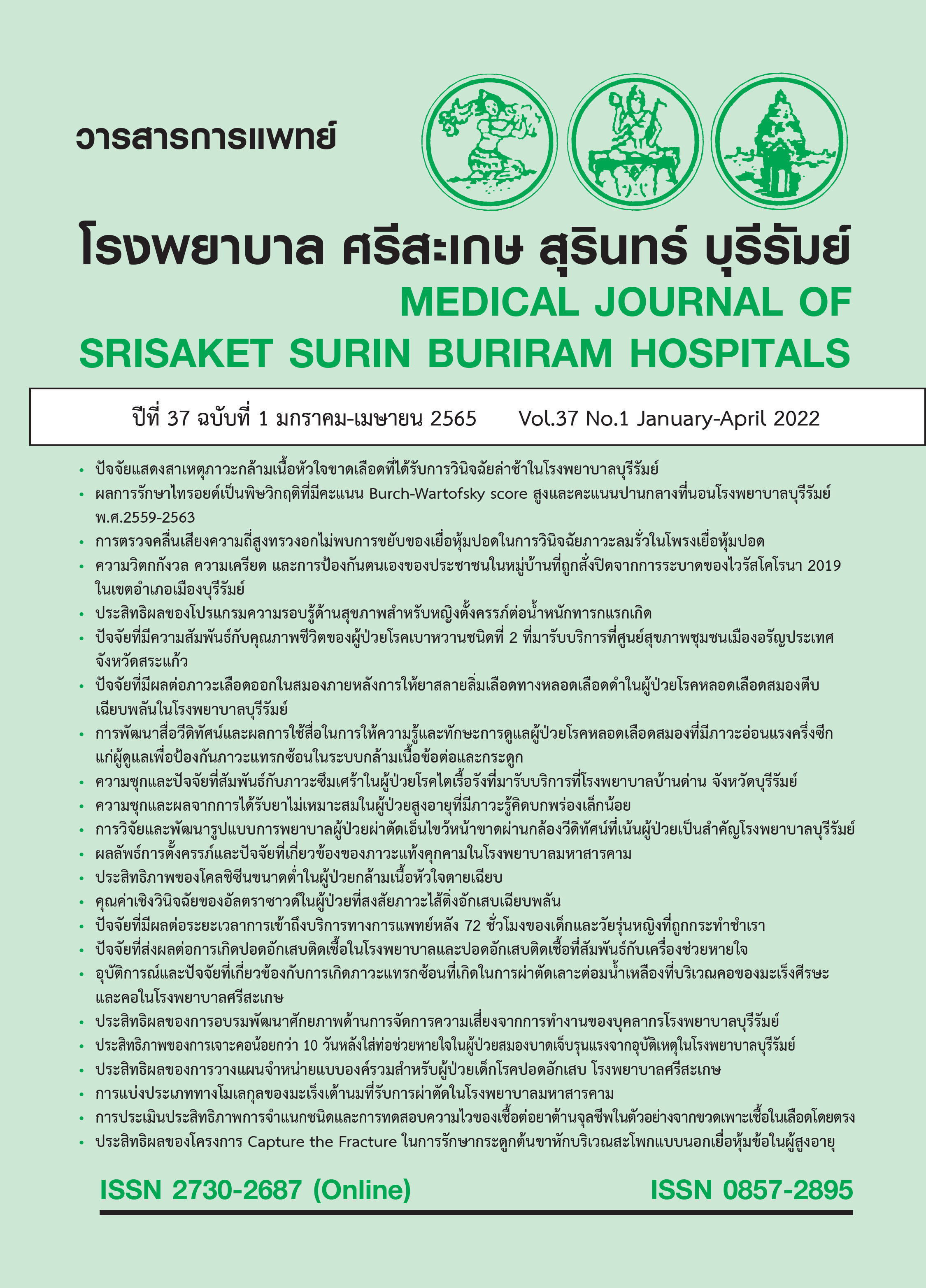ปัจจัยแสดงสาเหตุภาวะกล้ามเนื้อหัวใจขาดเลือดที่ได้รับการวินิจฉัยล่าช้า ในโรงพยาบาลบุรีรัมย์
Main Article Content
บทคัดย่อ
บทนำ: ภาวะกล้ามเนื้อหัวใจขาดเลือด (ST elevation myocardial infarction, STEMI) เป็นสาเหตุหลักที่ทำให้มีการเสียชีวิตในประชาชนทั่วไปการวินิจฉัยหลังจากเริ่มเจ็บหน้าอก ≥12 ชั่วโมง (late STEMI) ทำให้ระยะเวลาขาดเลือดของกล้ามเนื้อหัวใจนานมากขึ้นภาวะแทรกซ้อนและอัตราการเสียชีวิตสูงขึ้น การศึกษาปัจจัยที่สามารถแก้ไขได้ อาจลด late STEMI และอัตราการเสียชีวิตของผู้ป่วย
วัตถุประสงค์: เพื่อศึกษาปัจจัยที่ทำให้เกิดภาวะ late STEMI ที่ได้รับการพักรักษาที่โรงพยาบาลบุรีรัมย์
รูปแบบการศึกษา: การศึกษาแบบ prognostic factor research รูปแบบ retrospectiveobservational cohort design ของผู้ป่วยกล้ามเนื้อหัวใจขาดเลือด ขณะที่มารับการรักษาที่โรงพยาบาลบุรีรัมย์ตั้งแต่วันที่ 1 มกราคม พ.ศ. 2561 ถึง วันที่ 31 ตุลาคม พ.ศ.2563
วิธีการศึกษา: สืบค้นข้อมูลลักษณะทางคลินิกของผู้ป่วยที่มีภาวะกล้ามเนื้อหัวใจขาดเลือดจากเวชระเบียนโรงพยาบาลรวมถึงผลลัพธ์การรักษา วิเคราะห์หาปัจจัยที่ทำให้ผู้ป่วยได้รับการวินิจฉัยภาวะ late STEMI และพยากรณ์โรคในช่วงที่นอนโรงพยาบาลด้วย multivariable risk difference regression
ผลการศึกษา: จากผู้ป่วยทั้งหมด 619 คน พบว่ามี late STEMI 55 คน(ร้อบละ 8.9) และ Early STEMI 564 คน (ร้อยละ 91.1) ปัจจัยที่ทำให้วินิจฉัยได้ล่าช้าอย่างมีนัยสำคัญคือ ผู้ป่วยมาพบแพทย์ช้า (adjustedrisk difference ร้อยละ 72.8) การวินิจฉัยผิด (adjustedrisk difference ร้อยละ 71.4) และการมาด้วยอาการอื่น ส่วนปัจจัยด้าน เพศ อายุ โรคเบาหวาน โรคเส้นเลือดหัวใจขาดเลือดเดิม ยังไม่พบว่ามีนัยสำคัญทางสถิติ
สรุป: ปัจจัยหลักที่ทำให้วินิจฉัยได้ช้าของจังหวัดบุรีรัมย์คือ การที่ผู้ป่วยมาพบแพทย์ช้า และการวินิจฉัยที่ไม่ถูกต้องตั้งแต่แรก ทำให้มีอัตราการเสียชีวิตที่สูงขึ้น
Article Details

อนุญาตภายใต้เงื่อนไข Creative Commons Attribution-NonCommercial-NoDerivatives 4.0 International License.
เอกสารอ้างอิง
Denktas AE, Anderson HV, McCarthy J, Smalling RW. Total ischemic time: the correct focus of attention for optimal ST-segment elevation myocardial infarction care. JACC Cardiovasc Interv 2011;4(6):599-604. doi: 10.1016/j.jcin.2011.02.012.
Guerchicoff A, Brener SJ, Maehara A, Witzenbichler B, Fahy M, Xu K, et al. Impact of delay to reperfusion on reperfusion success, infarct size, and clinical outcomes in patients with ST-segment elevation myocardial infarction: the INFUSE-AMI Trial (INFUSE-Anterior Myocardial Infarction). JACC Cardiovasc Interv 2014;7(7):733-40. doi: 10.1016/j.jcin.2014.01.166.
Cohen M, Boiangiu C, Abidi M. Therapy for ST-segment elevation myocardial infarction patients who present late or are ineligible for reperfusion therapy. J Am Coll Cardiol 2010;55(18):1895-906. doi: 10.1016/j.jacc.2009.11.087.
Alkhalil M, Choudhury RP. Reperfusion Treatment in Late Presentation Acute Myocardial Infarction: Timing Is Not Everything. Circ Cardiovasc Interv 2018;11(9):e007287. doi:10.1161/CIRCINTERVENTIONS.118.007287.
Ibanez B, James S, Agewall S, Antunes MJ, Bucciarelli-Ducci C, Bueno H, et al. 2017 ESC Guidelines for the management of acute myocardial infarction in patients presenting with ST-segment elevation: The Task Force for the management of acute myocardial infarction in patients presenting with ST-segment elevation of the European Society of Cardiology (ESC). Eur Heart J 2018;39(2):119-77. doi:10.1093/eurheartj/ehx393.
O'Gara PT, Kushner FG, Ascheim DD, Casey DE Jr, Chung MK, de Lemos JA, et al. 2013 ACCF/AHA guideline for the management of ST-elevation myocardial infarction: a report of the American College of Cardiology Foundation/American Heart Association Task Force on Practice Guidelines. J Am Coll Cardiol 2013;61(4):e78-e140. doi: 10.1016/j.jacc.2012.11.019.
Schömig A, Ndrepepa G, Kastrati A. Late myocardial salvage: time to recognize its reality in the reperfusion therapy of acute myocardial infarction. Eur Heart J 2006;27(16):1900-7. doi: 10.1093/eurheartj/ehl174.
McNair PW, Bilchick KC, Keeley EC. Very late presentation in ST elevation myocardial infarction: Predictors and long-term mortality. Int J Cardiol Heart Vasc 2019;22:156-9. doi:10.1016/j.ijcha.2019.02.002.
Rodrigues JA, Melleu K, Schmidt MM, Gottschall CAM, Moraes MAP, Quadros AS. Independent Predictors of Late Presentation in Patients with ST-Segment Elevation Myocardial Infarction. [Article in English, Portuguese] Arq Bras Cardiol 2018;111(4):587-93. doi: 10.5935/abc.20180178.
Ting HH, Bradley EH, Wang Y, Lichtman JH, Nallamothu BK, Sullivan MD, et al. Factors associated with longer time from symptom onset to hospital presentation for patients with ST-elevation myocardial infarction. Arch Intern Med 2008;168(9):959-68. doi: 10.1001/archinte.168.9.959.
Killip T 3rd, Kimball JT. Treatment of myocardial infarction in a coronary care unit. A two year experience with 250 patients. Am J Cardiol 1967;20(4):457-64. doi: 10.1016/0002-9149(67)90023-9.
Taha R, Oraby M, Nasr G, El-Hawary A. Prevalence and causes of failure of receiving thrombolytic therapy in patients with acute ST-segment elevation myocardial infarction. Egypt Heart J 2013;65(2):51–5. https://doi.org/10.1016/j.ehj.2012.05.002


